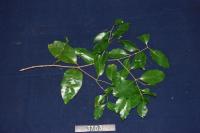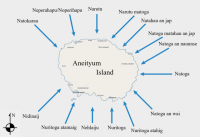This page has returned 100 entries
nohlaig
n. a species of seaweed
bookmarknohmun wai
n. bank (of a river)
bookmarknohmunjap
n. beach
bookmarknohoaig wai
n. the duck (constellation), the Southern Cross
bookmarknohoan
n. fruit; also "nohwan"
bookmarknohoanma
n. breadfruit; also "nohwanma"
bookmarknohoijam
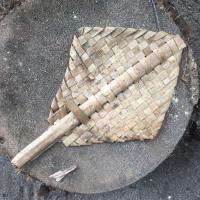
nohon
n. kind of taro
bookmarknohopcop

nohor
n. kind of taro
bookmarknohor

[nohor] n. Woodford’s Rail
Example: Illustration by John Gerrard Keulemans / Wikimedia Commons, License: Public domain via Wikimedia Commons
bookmarknohos aiyu
n. the sweet banana
bookmarknohos anhas
n. the Futuna banana
bookmarknohos esjig inwai
n. a banana
bookmarknohos futuna
n. the Futuna banana
bookmarknohos kaletonia
n. the New Caledonian banana
bookmarknohos New Zealand opah
nohos u nekrei
n. the flying-fox banana
bookmarknohos yau
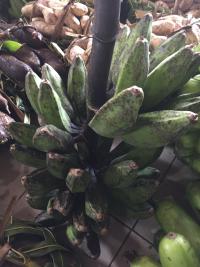
nohosma
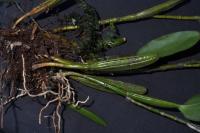
nohu itai
n. fruit trees
bookmarknohud ucnas
n. a bunch of taro; also "nuhud ucnas"
bookmarknohun
n. stem
bookmarknohwai itai
n. berry
bookmarknohwai itai
n. corn
bookmarknohwai vaine mese
n. raisin
bookmarknohwan ajimta
n. kind of taro
bookmarknohwan aruman
n. kind of taro
bookmarknohwan nefara
n. kind of taro
bookmarknohwan nuputu
n. kind of taro
bookmarknohwan yag
n. kind of taro
bookmarknokoko

n. tree, 3-4 m tall (collection: Gregory M. Plunkett #3540)
Example: The straight trunk of this tree is used to make canoes. The black seed in the fruit is used to make necklaces. The inner bark is peeled and crushed in sea water and rubbed in the hair to make it curly. People do this treatment every day to make long hair curl like a rasta.
bookmarknokoko

n. large well branched tree, 18-20 m tall (collection: Gregory M. Plunkett #3216)
Example: 1. The trunk of this plant is used to make canoes. 2. It is also a good timber for the inside part of houses. 3. Mix the sap from the stem with other unspecified leaves and rub them into dreadlocks. 4. To attract shells in the sea, scrape a branch and drop in the sea where shells are attracted to the branches and they can be collected for sale to the Island’s visitors. 5. Seeds are used to make beautiful black necklaces. Said to be a lot of work as it is difficult to remove the seed. Rub with sandpaper or soak in water and then make the hole in the seed. 6. Fruit is a children’s toy – used as a whistle to make a nice sound.
bookmarknokoro vai cai oho
n. orchard
bookmarknom̃o

nomodej wow
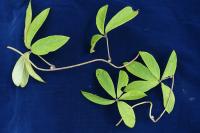
n. vine to 2 m, aerial tubers and lobed leaves. (collection: Michael J. Balick #4946)
Example: This is a root crop. It is harvested in April-June. The leaves turn yellow and indicate that the crop is ready to harvest. If planted in the old days the root would get much larger. It is a good cyclone disaster food. Grows wild now. Boil the tuber in fresh water, when it is cooked add a bit of sea water to give it a salty taste. Chew the starchy root and spit out the fiber. Another variety is like sweet potato and a person can eat the entire root without spitting out the fiber. Can mix with coconut milk as well to eat.
bookmarknomoj

n. cycad to 3 m tall, 25 cm dbh (collection: Michael J. Balick #5010)
Example: In the past there were no toys for the children, so people made toys from the seed of this plant. They peeled the fruit, took the seed, removed the inside, punched one hole on each side, put a string through each of the holes and twisted the string to spin the seed such that it would make a whistling sound as the fruit spun faster and faster. On Palm Sunday, people use this leaf in Church. People plant this cycad around their homes and use it as an ornamental. Some people believe that having this plant around their homes will keep the bad spirits away.
bookmarknomojced

n. terrestrial fern growing in rain forest on the mountain slope. Leaves dimorphic. (collection: Gregory M. Plunkett #3285)
bookmarknomotan

n. Spangled emperor
Example: Photo by Richard Ling, License: CC BY-SA 3.0 via Fishes of Australia
bookmarknomotmot
n. grass
bookmarknomotmot ijis
n. kind of plant, grass, or fern
bookmarknomotmot mese
n. hay
bookmarknomotmot tucjup
n. kind of plant, grass, or fern
bookmarknomrop̃om̃

nomropom

n. shrub to 2 m, flowers white (collection: Michael J. Balick #4874)
Example: This plant is an indicator of rich soil, especially up on the hills from the coast. Therefore, this is where people choose to do their gardens. This specimen is in red soil that is not rich so it does not grow tall, but in the mountains it does grow tall and that is where gardens are planted. Wood from the tree is used for carving.
bookmarknomyatamain

n. Thumbprint emperor, blackspot emperor
Example: Photo by ANFC, License: CC BY-NC 3.0 via Fishes of Australia
bookmarknononhat

n. Blue-lined large-eye bream
Example: Photo by Jean-Lou Justine / Wikimedia Commons, License: CC BY-SA 3.0 via Fishes of Australia
bookmarknop̃a
[nok͡pa] adj. grey ash (color)
bookmarknopan
n. a season
bookmarknopna

[nopɲa] n. Red-Bellied Fruit Dove
Example: Sub-adult Red-bellied Fruit Dove. Photo by Papier K / Wikimedia Commons, License: CC BY-SA 3.0 via Wikimedia Commons
bookmarknop̃oe

nopoi
n. species of vine runner; a basket net
bookmarknop̃oi

n. sprawling, vine-like herb (collection: Gregory M. Plunkett #3215)
Example: 1. The flower of this plant is used for decoration, for Christmas in particular, in church and home. 2. To attract a mate, put the flower in your hair. 3. This is the introduced one that is named after the wild type.
bookmarknoporo pora

noporo pora

noposeri

n. tree, 3 m tall (collection: Gregory M. Plunkett #3506)
Example: 1. The leaves of this plant are used in a kastom ceremony; crush the leaves and put in a head garland or on an arm band to release a pleasant odor during a kastom dance. The name of the plant is stated in a kastom song. 2. The leaf is a component for making "love magic." Crush these leaves as well as other unspecified leaves in a person’s hand while stating the name of the person you wish to fall in love with you, and it is said that they will. 3. Message plant – There are special people who compose traditional song about the person or legends, history, so the person who wants the song gives the composer this plant with other unspecified plants and the composer will have a dream that night and spirits will give song and melody and compose a song. Song is for Kastom ceremony singing while dancing.
bookmarknop̃ou

n. large epiphyte on dead tree, growing in open forest. (collection: Gregory M. Plunkett #3478)
Example: The wood of this plant is very hard and can be used for house posts. Because the wood is somewhat heavy, younger stems can be sharpened at one end and the pole can be used to plant dryland taro, to make holes for the tubers. For planting swamp taro, the leaves can be used to line the pit that the taro is planted in; it is a local fertilizer for the taro, and as it rots the soil becomes soft while the taro is growing. The flowers are placed behind one’s ear to enjoy the fragrance or can also be used to make a floral necklace (Intañ).
bookmarknopou

n. tree to 5 m, dbh 10 cm (collection: Michael J. Balick #4881)
Example: The wood of this tree is used to make house-posts, it is strong. The leaves are used as a compost for the taro patch; line the hole with the leaves of this tree, then place soil over that and plant the taro. When the fruits are ripe, local people say that the hermit crabs are "fat" and ready to collect and eat. When a person is in the forest and there is no coconut fruit fiber to start a fire with, use a dry stick, shave it and use a match to start a pile of this tinder to make a good fire. The wood is said to be "oily." This gives it a nice aroma. To perfume coconut oil, drop the dry flowers in it--use 1 handful of dried flowers added to a pot of oil boiling on the fire while making it. Strain out flowers and the oil smells good. Flowers can also be added to the oil once it is bottled to perfume it.
bookmarknop̃ou

n. tree. Found in the village, usually grows in the hills. (collection: Ashley A McGuigan #16)
Example: 1. Lot of oil in the heartwood so it is good to start a fire, split it into small strips and you can light it for a fire. 2. Calendar plant – when the fruits ripen people know that this is the best season to eat the big hermit crab – meaning that they are fat.
bookmarknopropra (~ noporopora ?)

nopugei

nopwag

noragidi
nosjacai

n. Two-striped sweetlips, giant sweetlips
Example: Photo by Ross D. Robertson / Shorefishes of the Neotropics, License: CC BY-SA 3.0 via Fishes of Australia
bookmarknosocrei
n. kind of plant, grass, or fern
bookmarknouhap̃

n. shrub, 2. 5 m tall (collection: Gregory M. Plunkett #3511)
Example: 1. Use the leaves to put in a hole where taro is being planted, as a sort of fertilizer--it rots easily and adds value to the soil. To protect a person from spirits if you are going to an unfamiliar place, take the young inflorescence and put behind your ear. This plant is a sort of "spiritual kava." 2. Flowers are put behind one ear, any side, to allow a person to pass through sacred places. For protection of the spirits especially if you are familiar with this place. On EAST SIDE, put one leaf under pillow before sleeping so that the lady spirit will not disturb the person. Only for men – spirit likes men, and wants to have sleep with them. If she gets pregnant, you must follow her to look after the kids in the spirit world so you leave this one (you die). 3. The small, straight stems of this plant are used as rafters to weave thatch. 4. Children make bows and arrows from the stems as well as spears for fishing.
bookmarknouraju

n. shrub to 1 m, flowers green (collection: Michael J. Balick #4895)
Example: To make bush ropes, remove outer bark, use to tie things when other ropes are not available. This plant is sour and toxic if the fruits or leaves are eaten. Animals will not eat this plant. The elders teach us not to eat this plant.
bookmarknouras
nouras

n. tree, 3-4 m tall (collection: Gregory M. Plunkett #3571)
Example: As a medicinal plant, take the ripe fruits, put it in a dish or bucket, squeeze out the juice and save it for drinking. The dose is 1 tablespoon, morning and afternoon if a person feels tired. This treatment will help give energy to a person. The leaves are placed on the bottom and top of an earth oven to help cook the food. The leaves are also used to wrap shellfish for cooking over a fire. When chewing kava root to prepare it for drinking, put the piles of chewed root on top of this leaf to keep it clean. Some men cut the green fruit in half and rub it against the skin of their face after shaving to protect the skin from rashes and irritations.
bookmark





